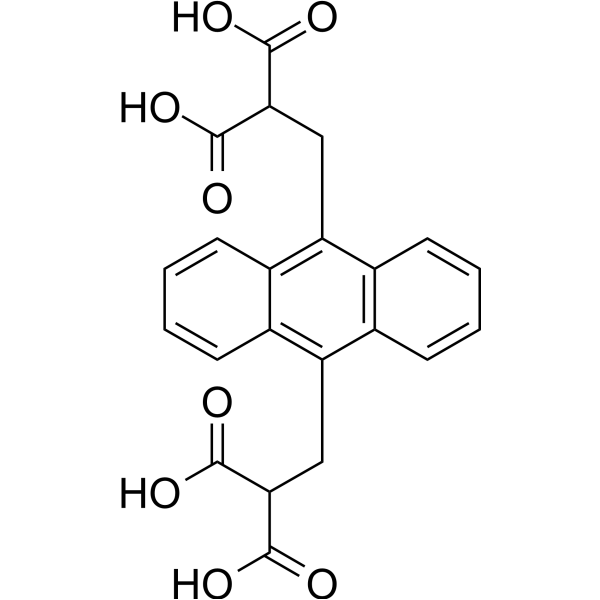
9,10-Anthracenediyl-bis(methylene)dimalonic acid (ABDA) is a biological dye and indicator used to detect singlet oxygen generation (SOG). 9,10-Anthracenediyl-bis(methylene)dimalonic acid can be photobleached by singlet oxygen to its corresponding endoperoxide. This reaction can be monitored spectrophotometrically by recording the decrease of absorbance at 400 nm.
| Molecular Weight | 410.37 |
| Formula | C22H18O8 |
| CAS Number | 307554-62-7 |
| Form | Solid |
| Solubility (25°C) | DMSO 30 mg/mL Water |
| Storage | 4°C, protect from light, dry, sealed |
| Species | Mouse | Rat | Rabbit | Guinea pig | Hamster | Dog |
| Weight (kg) | 0.02 | 0.15 | 1.8 | 0.4 | 0.08 | 10 |
| Body Surface Area (m2) | 0.007 | 0.025 | 0.15 | 0.05 | 0.02 | 0.5 |
| Km factor | 3 | 6 | 12 | 8 | 5 | 20 |
| Animal A (mg/kg) = Animal B (mg/kg) multiplied by | Animal B Km |
| Animal A Km |
For example, to modify the dose of Compound A used for a mouse (20 mg/kg) to a dose based on the BSA for a rat, multiply 20 mg/kg by the Km factor for a mouse and then divide by the Km factor for a rat. This calculation results in a rat equivalent dose for Compound A of 10 mg/kg.
| Related Fluorescent Dye Products |
|---|
| SOSG
SOSG (Singlet Oxygen Sensor Green Fluorescent Probe) is highly selective for singlet oxygen (1O2). It is commonly used for the detection of singlet oxygen in solutions and the evaluation of the efficacy of free radical scavengers. |
| FM1-43
FM1-43 is a very lipophilic, water-soluble styrene dyes, can specifically bind to cell membranes and inner membrane organelles to produce fluorescence. FM1-43 is widely used in endocytic and exospic membrane structure markers. |
| BCIP
BCIP is a chromogenic substrate for colorimetric assay of alkaline phosphatase activity. |
| MCA-SEVNLDAEFR-K(Dnp)-RR, amide
MCA-SEVNLDAEFR-K(Dnp)-RR, amide is a FRET-based substrate. |
| MeOSuc-AAPV-AMC
MeOSuc-AAPV-AMC is a fluorogenic substrate for human leukocyte and porcine pancreatic elastase (Km: 362 μM, Ex=380 nm, Em=460 nm). |


Products are for research use only. Not for human use. We do not sell to patients.
© Copyright 2010-2023 AbMole BioScience. All Rights Reserved.
